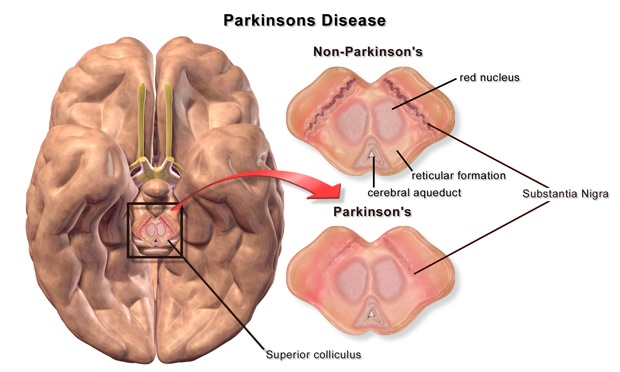Parkinson's Disease

No specific test exists to diagnose Parkinson's disease. Your doctor trained in nervous system conditions (neurologist) will diagnose Parkinson's disease based on your medical history, a review of your signs and symptoms, and a neurological and physical examination. Parkinson's disease (PD) belongs to a group of conditions called motor system disorders, which are the result of the loss of dopamine-producing brain cells. The four primary symptoms of PD are tremor, or trembling in hands, arms, legs, jaw, and face; rigidity, or stiffness of the limbs and trunk; bradykinesia, or slowness of movement;. The Michael J. Fox Foundation is dedicated to finding a cure for Parkinson's disease through an aggressively funded research agenda and to ensuring the development of improved therapies for those living with Parkinson's today. Parkinson’s disease affects the nerve cells in the brain that produce dopamine. Parkinson’s disease symptoms include muscle rigidity, tremors, and changes in speech and gait. After diagnosis.
Symptoms Of Parkinson's Disease
Parkinson'beds is usually a disease óf the that mostly affects old people. It usually starts after the age of 50. The disease can become very tough to live with because it significantly restricts flexibility and as a outcome makes everyday activities significantly challenging. Parkinson'h is certainly a, which means that in many situations it will carry on to gradually obtain worse. Many people who develop Parkinson'beds will need nursing treatment.
There is usually no treatment for the diséase and its specific cause is not recognized, but there are usually effective that can reduce the symptoms. Symptoms The signs of Parkinson'beds can become very various. The regular symptoms are usually. Evidence testimonials Bibliographic details: Yáng LH, Du YH, Xióng M, Liu JL, Wang YN, Li Y, Li LN. Acupuncture treatment for Parkinson disease: a organized review. Chinese Record of Evidence-Based Medicine 2010; 10(6): 711-717 One of the complications of lengthy‐term therapy of Parkinson'beds disease (PD) with levodopa can be the growth of engine complications y.gary the gadget guy. Dyskinesia; a jerky, dancing‐like movement of the entire body.
Generally clinicians include on medications (to the levodopa routine) from one of the various other three classes of anti‐Parkinsonian treatments available (y.gary the gadget guy. Dopamine agonists, catechoI‐O‐methyl transférase inhibitors (COMTIs) ór monoamine oxidase kind T inhibitors (MAOBIs)). Nevertheless, despite trials having proven that these medications are advantageous compared to placebo, it remains ambiguous as to the greatest method to deal with patients suffering from motor complications and, in specific, whether one class of medication may end up being more efficient than another.
Placebo, or sham procedure, as a handle situation in surgical clinical studies in Parkinson disease (PD) remains debatable. The writers analyzed the undesirable effects reported in double blind, placebo surgery treatment controlled tests for PD. Placebo operations were generally safe and well tolerated but the quantity of topics getting the process was small. Harm occurred more often in topics randomized to the experimental involvement. Summaries for customers One of the complications of long‐term therapy of Parkinson'h disease (PD) with levodopa is usually the growth of electric motor complications at the.h. Dyskinesia; a jerky, dancing‐like motion of the entire body. Generally physicians add on medications (to the levodopa program) from one of the additional three lessons of anti‐Parkinsonian remedies obtainable (age.h.
Dopamine agonists, catechoI‐O‐methyl transférase inhibitors (COMTIs) ór monoamine oxidase type T inhibitors (MAOBIs)). Nevertheless, despite studies having shown that these medications are advantageous compared to placebo, it remains unclear as to the greatest method to deal with patients suffering from motor problems and, in particular, whether one class of drug may be more effective than another. History: Long‐term levodopa therapy in Parkinson'h disease is certainly linked with the development of electric motor complications including irregular involuntary motions and a shortening response to each dose (wearing off phenomenon).
Digital dj pro professional dj mixing software for mac. It can be thought that dopamine agonists can reduce the length of time of immobile off periods and the need for levodopa therapy whilst sustaining or enhancing engine impairments and only minimally raising dopaminergic adverse events. Background: Lengthy‐term levodopa therapy in Parkinson's i9000 disease can be associated with the growth of electric motor complications like abnormal involuntary movements and a shortening reaction to each dosage (putting on off trend). It is usually believed that dopamine agonists can reduce the duration of immobile off intervals and the need for levodopa treatment whilst maintaining or improving engine impairments and only minimally boosting dopaminergic undesirable events. Terms to understand Slow motion. Disability of voluntary muscle mass control, characterized by spasmodic or recurring motions or absence of coordination. An activity that will be not made by option.
In the body, involuntary actions (like as blushing) happen immediately, and cannot end up being controlled by option. Neurological problems producing in irregular voluntary or involuntary motion, which may influence the velocity, fluency, quality and convenience of movement. Getting to do with spirit or the nervous program. A doctor who is an expert in the analysis and therapy of problems of the anxious program. Unintentional trembling or trembling of one or even more body parts. Talk about on Facebook. Share on Twitter.
Share on Google+.